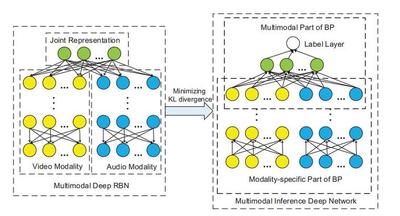The inherent dependencies between visual elements and aural elements are crucial for affective video content analyses, yet have not been successfully exploited. Therefore, we propose a multimodal deep regression Bayesian network (MMDRBN) to capture the dependencies between visual elements and aural elements for affective video content analyses. The regression Bayesian network (RBN) is a directed graphical model consisting of one latent layer and one visible layer. Due to the explaining away effect in Bayesian networks (BN), RBN is able to capture both the dependencies among the latent variables given the observation and the dependencies among visible variables. We propose a fast learning algorithm to learn the RBN. For the MMDRBN, first, we learn several RBNs layer-wisely from visual modality and audio modality respectively. Then we stack these RBNs and obtain two deep networks. After that, a joint representation is extracted from the top layers of the two deep networks, and thus captures the high order dependencies between visual modality and audio modality. In order to predict the valence or arousal score of video contents, we initialize a feed-forward inference network from the MMDRBN whose inference is intractable by minimizing the KullbackCLeibler (KL)divergence between the two networks. The back propagation algorithm is adopted for finetuning the inference network. Experimental results on the LIRIS-ACCEDE database demonstrate that the proposed MMDRBN successfully captures the dependencies between visual and audio elements, and thus achieves better performance compared with state-of-the-art work.
